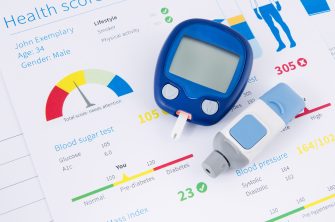How to Deal with Hyperglycemia
 It is not uncommon for people to trivialize hyperglycemia, sometimes referred to as pre-diabetes. It is characterized by fasting blood glucose levels that exceed 100 mg/dL or a two-hour postprandial glucose level greater than 140 mg/dL, but less than 200 mg/dL, which reflects overt diabetes. This may be due to the fact that the potential clinical impact of hyperglycemia is not adequately emphasized.
It is not uncommon for people to trivialize hyperglycemia, sometimes referred to as pre-diabetes. It is characterized by fasting blood glucose levels that exceed 100 mg/dL or a two-hour postprandial glucose level greater than 140 mg/dL, but less than 200 mg/dL, which reflects overt diabetes. This may be due to the fact that the potential clinical impact of hyperglycemia is not adequately emphasized.
Did you know a study that considered hyperglycemia and disease expression concluded that, “the findings support the hypothesis that higher postprandial glycemia is a universal mechanism for disease progression”?
It is specifically important to know which diseases are promoted by hyperglycemia, which is one component of the metabolic syndrome. Most people understand that there is a connection to diabetes and heart disease; however, the urgency of this problem is often not realized. Perhaps this is because hyperglycemia is not typically associated with pain or other symptoms and so, the insidious nature of diabetes and heart disease is commonly not felt until there is adequate damage occurring in major organs.
In addition to diabetes and heart disease, many other conditions are known to be promoted by hyperglycemia/metabolic syndrome including cancer, fatty liver disease and cirrhosis, gallstone disease, sleep apnea, and hypertension. Women concerned about breast cancer and individuals with hypertension are rarely told that hyperglycemia is an underlying cause of these conditions. In the case of cancer, it is well documented that tumors thrive on glucose and so hyperglycemia must be avoided. With this knowledge about hyperglycemia and disease expression, it is possible to understand hyperglycemia in a way that leads to improved health choices.
Diet and supplementation to combat hyperglycemia
Proper diet and the use of dietary supplements can eliminate the hyperglycemia/metabolic syndrome and it need not be overly difficult. A healthy diet that includes lean protein and tubers such as sweet potatoes may be enough to fulfil the dietary component. Exercise and caloric intake should be tailored to get the body mass index below 25.
Supplementation can be equally straightforward, and first, it is important to understand that no supplement or medication cures the metabolic syndrome in the absence of dietary change. Instead, the approach should be to eat anti-inflammatory foods and support the diet with key supplements.
The key nutrients for supporting proper glucose metabolism from a physiological and economic perspective include vitamin D, magnesium, chromium and lipoic acid. The recommended levels of supplemental nutrients are listed below. Vitamin D is the only nutrient that can be measured and supplemented based on lab results, which means that vitamin D supplementation can vary substantially.
Table 1. Supplemental nutrients
| Supplement | Amount |
| Vitamin D3 (cholecalciferol) | 4000-10,000 IU per day |
| Magnesium | 400-1000 mg in divided doses |
| Chromium | 200-300 mcg tid |
| Lipoic acid | 200 mg tid |
Vitamin D should be taken with meals, as it is fat soluble, while magnesium, chromium, and lipoic acid should be taken on an empty stomach, at least 1 hour before meals.
Table 1 is provided as an example of a supplementation regime. Important to note is that there has never been a study wherein rigorous dietary changes were made and maintained, which were simultaneously complemented by the above-mentioned nutritional supplements. Consequently, monitoring of blood glucose levels is mandatory so as to avoid hypoglycemia.
For personalized dietary and nutritional supplement regimens, talk to your doctor of chiropractic. They have a wealth of information for you about healthy lifestyle changes you can make to protect yourself and your family.
SOURCE: How to deal with hyperglycemia
By David Seaman, DC, Professor, Clinical Sciences, National University of Health Sciences, Pinellas Park, FL and frequent speaker/contributor for the TCA. Originally published in the TCA Journal, June 2012.